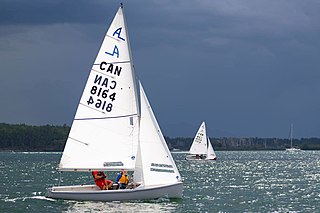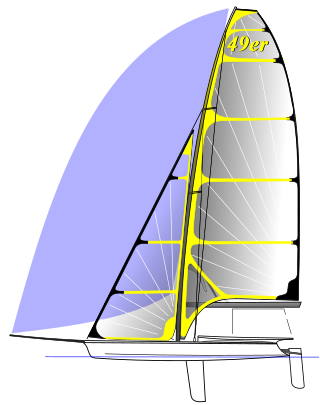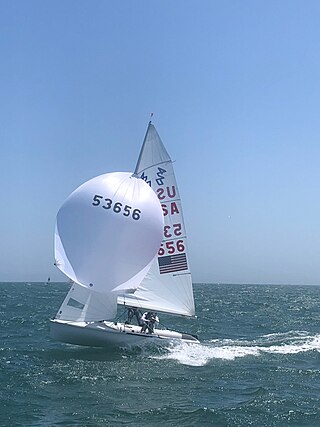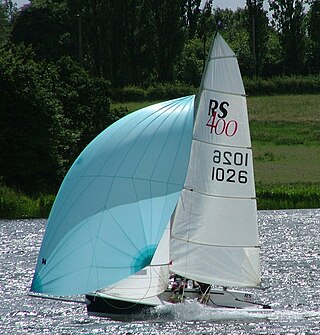
The Albacore is a 4.57 m (15 ft) two-person planing dinghy with fractional sloop rig, for competitive racing and lake and near-inshore day sailing. Hulls are made of either wood or fiberglass. The basic shape was developed in 1954 from an Uffa Fox design, the Swordfish. Recent boats retain the same classic dimensions, and use modern materials and modern control systems.

The GP14 is a wooden or fibreglass hulled double-handed fractional Bermuda rigged sailing dinghy designed by Jack Holt in 1949.

The Laser is a class of single-handed, one-design sailing dinghies using a common hull design with three interchangeable rigs of different sail areas, appropriate to a given combination of wind strength and crew weight. Ian Bruce and Bruce Kirby designed the Laser in 1970 with an emphasis on simplicity and performance.

The 470 (Four-Seventy) is a double-handed monohull planing dinghy with a centreboard, Bermuda rig, and centre sheeting. Equipped with a spinnaker, trapeze and a large sail-area-to-weight ratio, it is designed to plane easily, and good teamwork is necessary to sail it well. The name comes from the boat's length of 470 centimetres.

The 49er and 49er FX is a two-handed skiff-type high-performance sailing dinghy. The two crew work on different roles with the helm making many tactical decisions, as well as steering, and the crew doing most of the sail control. Both of the crew are equipped with their own trapeze and sailing is done while cantilevered over the water to the fullest extent to balance against the sails.

The International 420 Dinghy is a sailing dinghy popular for racing and teaching. The hull is fiberglass with internal buoyancy tanks. The 420 has a bermuda rig, spinnaker and trapeze. It has a large sail-area-to-weight ratio, and is designed to plane easily. The 420 is an International class recognised by World Sailing. The name refers to the boat's length of 420 centimetres.

The Fireball is a British sailing dinghy that was designed by Peter Milne as a one-design racer and first built in 1962.

The Tasar is a 14.83-foot (4.52 m) fiberglass 2 person sailing dinghy with a mainsail and jib. Designed by Frank Bethwaite of Sydney in 1975, the boat was technologically advanced for its time and continues to evolve. Aimed at a husband-and-wife or parent-and-child crew hence no spinnaker, it is designed for a combined crew weight of around 140 kg. The hull weighs 68 kg, and is of sandwich foam construction. The hull has a fine angle at the bow to reduce wave impact drag with unusually clean and sharp chines aft to ensure very free planing and outstanding stability. The foam cored hull is stiff and light and the advanced hull shape, together with an innovative rig which combines a rotating mast with a fully battened main sail, allows the Tasar to plane upwind with the crew normally hiked. The wide beam and a cockpit designed for comfortable hiking make the Tasar easy, fun and very exciting to sail in winds up to 25 knots (46 km/h).

The 29er is a two-person high performance sailing skiff designed by Julian Bethwaite and first produced in 1998. Derived from the Olympic class 49er class, it is raced in the ISAF Youth Sailing World Championships. The 29er is able to reach high speeds fairly quickly by having a sleek and hydrodynamic hull and will often exceed the wind speed when planing both up and downwind.

The International 14 is a British racing sailboat, crewed by two sailors. The class was established in 1928.

The RS800 is a light-weight sailing dinghy designed by Phil Morrison and manufactured by RS Sailing. The boat is sailed by two people both on trapeze and has a main, jib and spinnaker. The RS800 has a Portsmouth Yardstick number of 799 and a D-PN of 77.0. There is a large racing circuit in the UK, and some European events each year.
The Pacer class of sailing dinghy, formerly known as the Puffin Pacer, was designed in the United Kingdom by Jack Holt. It was commissioned by Puffin Paints and Glues to be designed as sailing dinghy for use by families, so needing to be larger than their earlier Puffin dinghy. It has since become a popular learning and racing dinghy in Australia, Canada, the Netherlands, India and the UK. The name was changed in the UK early 1970s, although Australia continued to use the name until 1989, when they followed the UK in dropping the "puffin" and chose the wedge-tailed shearwater as the boat's symbol.

The Laser 3000 is a racing sailing dinghy crewed by two persons with a trapeze for the crew. Launched in 1996, the 3000 was developed from the Laser 2, using the original Frank Bethwaite-designed planing hull combined with a brand new self-draining deck by Derek Clark. Clark also re-designed the rig, using spars and sails from premium proprietary sources and replacing the symmetric spinnaker of the Laser 2 by a larger asymmetrical spinnaker. The gennaker is chute-launched and retrieved using a single halyard line, and is set on a retractable bowsprit. Helm balance and handling were improved using a shorter-footed mainsail with two full-width battens giving a larger roach. A mast with conventional spreaders replaced the now-unusual diamond arrangement of the Laser 2.

The RS Feva is a two-person sailing dinghy designed by Paul Handley in 2002. It is manufactured and distributed by RS Sailing. The RS Feva is an International Sailing Federation (ISAF) International Class, a Royal Yachting Association (RYA) Supported Junior Class, and has been selected by the Dansk Sejlunion and Norges Seilforbund for major sailing growth projects.

The 3000 is a racing sailing dinghy crewed by two persons with a trapeze for the crew. Launched in 1996 as the Laser 3000, the 3000 was developed from the Laser 2, using the original Frank Bethwaite-designed planing hull combined with a new designed self-draining deck by Derek Clark. Clark also re-designed the rig, using spars and sails from premium proprietary sources and replacing the symmetric spinnaker of the Laser 2 by a larger asymmetric spinnaker (gennaker). The gennaker is chute-launched and retrieved using a single halyard line, and is set on a retractable bowsprit. Helm balance and handling were improved using a shorter-footed mainsail with two full-width battens giving a larger roach. A mast with conventional spreaders replaced the now-unusual diamond arrangement of the Laser 2.

The RS400 is a light-weight sailing dinghy designed by Phil Morrison and manufactured by RS Sailing. The dinghy is sailed by two people and has a main, a jib and an asymmetric spinnaker. It has a PY of 948 and a D-PN of 82.3.
The RS700 is a single-handed racing dinghy built by RS Sailing and designed in 2000 by Nick Peters and Alex Southon as part of the RS series and built in 2001. It is raced in many sailing clubs around Britain, with a PY number of 850 and a D-PN of 73.3.
ISO is an International Sailing Federation (ISAF) class of two-person sailing dinghy with a single trapeze and an asymmetric spinnaker. The ISO was designed in 1993 by Ian Howlett and John Caig and manufactured by Reg White Limited of Brightlingsea as part of the "White Formula" range of boats originally marketed by Topper International Ltd and since 2013 by Vantage Sailing Ltd. The boat has a fully battened mainsail, jib and an asymmetric spinnaker.

The Wētā 4.4 Trimaran is a 4.4 metre sailing dinghy conceived and developed in New Zealand from 2001-2006 by Roger and Chris Kitchen and others with original drawings by TC Design's Tim Clissold.

The Topper Topaz is a British single-handed or two-handed sailing dinghy that was designed as a beginner and intermediate racer.

















